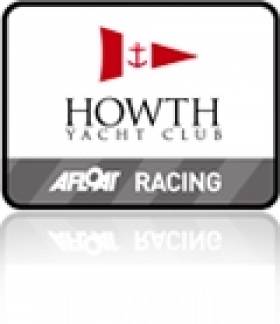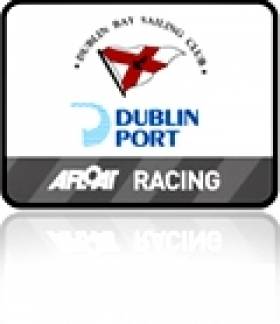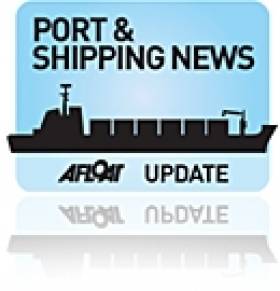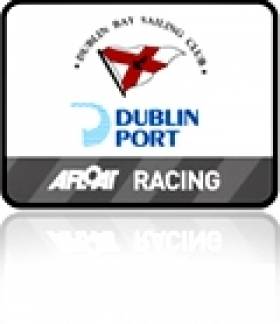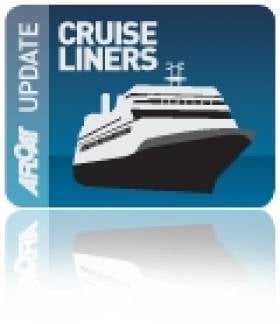Displaying items by tag: Dublin Bay
America's Cup Legend Lines up for Howth Etchells Regatta
America's Cup legend John Bertrand is among 42 entries received for the Etchells World Championships coming to Howth Yacht Club later this month. A quarter of the fleet are Irish but entries are also coming from Australia, Bermuda, USA and Sweden. Bertrand and his crew are coming from Victoria in Australia. Bertrand skippered Australia II to victory in the 1983 America's Cup, ending 132 years of American supremacy. Bertrand won the bronze medal in the Finn competition at the 1976 Summer Olympics in Montreal. He is a member of Royal Brighton Yacht Club in Melbourne Australia, and currently competes in the Etchells class boats. The Howth entry list as at July 30th can be downloaded below.
Rita Beats Oona in HYC Seventeen's Race
HOWTH YACHT CLUB. TUE + SAT SERIES 3 (RACE) 03/08/2010 17 Footer SCRATCH: 1, Rita Lynch/Curley; 2, Aura I Malcolm; 3, Oona P Courtney; 17 Footer HCAP: 1, Aura I Malcolm; 2, Pauline O'Doherty/Ryan; 3, Rita Lynch/Curley TUESDAY SERIES 3 (RACE) 03/08/2010 Puppeteer SCRATCH: 1, Mojo Stanley/Callen; 2, Ibis G May; 3, Pinocchio Swan/Davidson; Puppeteer HPH: 1, Mr. Punch NiBhraonain/Wilson; 2, Pinocchio Swan/Davidson; 3, No Strings T Harvey; Squib SCRATCH: 1, Chatterbox J Kay; 2, Shadowfax P Merry; 3, Arctic Fox G Barry; Squib HPH: 1, Chatterbox J Kay; 2, Shadowfax P Merry; 3, Arctic Fox G Barry; Etchells SCRATCH: 1, Kootamundra Wattle O'Grady/Reilly; 2, Jabberwocky S Knowles; 3, Northside Dragon J Bourke; SB3 SCRATCH: 1, Sharkbait Duncan/Moran; 2, Sin a Bhuifl Guinness/Costigan; 3, Investwise D Quinn
Pterodactyl Wins DBSC Glen Race
DUBLIN PORT Dublin Bay Sailing Club Results for 3 AUGUST 2010
CRUISERS 2 - 1. Cor Baby (Keith Kiernan et al), 2. Red Rhum (J Nicholson), 3. Borraine (Ean Pugh)
CRUISERS 3 - 1. Papytoo (M.Walsh/F.Guilfoyle), 2. Rattler 2 (Austin Whelan), 3. Grasshopper 2 (K & J Glynn)
CRUISERS 4 - 1. Aslana (J.Martin/B.Mulkeen), 2. Maranda (Myles Kelly), 3. Artemis (J.Giles)
GLEN - 1. Pterodactyl (R & D McCaffrey), 2. Glenshesk (L.Faulkner et al)
RUFFIAN 23 - 1. Shillelagh (J.Caldwell/D.Barber), 2. Diane ll (Bruce Carswell), 3. The Sting (Richard O'Keefe et al)
SIGMA 33 - 1. White Mischief (Timothy Goodbody), 2. Pippa lV (G.Kinsman/K.Blake/M.O'Brien), 3. Pastiche (John Peart et al)
Italians Bring Home Irish Military Equipment from Africa
On Monday 26 July, the Grande Senegal, a brand new vessel that was only launched this year for Italian shipping giant, Grimaldi Lines, docked in Dublin after a 9,600km voyage from Douala, Cameroon, along Africa's mid-western coast.
Onboard was a large-scale consignment of Irish Defence Forces military equipment from Chad, writes Jehan Ashmore.
The charter of the 47,218 gross tonnes marked the final phase in the withdrawel since April of Irish Defence Forces from UN-peacekeeping duties in the troubled land-locked central African state. The Irish-based troops had already flown home in advance of the military hardware.
In total, 3,000 tonnes of equipment was shipped which included 208 TEU (20-foot long containers) 75 trucks, 4x4s, armoured vehicles and an assortment of trailers and fuel bowsers.
The cargo was first moved from Defence Force facilities based at Goz Beida, in eastern Chad, across 900km of desert to the Chadian capital, N'Djamena. From there the equipment was divided with sensitive cargo flown to the port of Douala. The remaining cargo was taken on another 900km road-trip to Ngaoundere, in northern Cameroon. Upon arrival at Ngaoundere, the cargo was transferred by rail for 650km to Douala, finally completing the journey to the African port.
The transportation was undertaken during the impending threat of the rainy season which can pose serious difficulties for all modes of
wheeled transport to the extent that renders progress to be difficult if not impossible. The major logisticical exercise was one of the most
challenging operations experienced by the Defence Forces.
With the equipment loaded at Douala, Grande Senegal set sail on 13 July bound for Dublin. The long-distance passage took a fortnight to arrive at Dublin, where the ConRo (Containers and Roll-On Roll-Off) vessel discharged vehicles through the stern-mounted door ramp.
Once the equipment was disembarked at the quayside, the Gardai and Defence Forces provided joint escorts to the vehicle-conveys, to ensure a speedy exit out of the port, destined for military barracks. Grande Senegal is one of seven Grande 'Angola' class newbuilds built at the Uljanik Shipyard, Pula, Croatia. Each 210 metre-long ConRo vessel can combine a load of 2000 vehicles and 800 TEU, or alternatively a maximum of 1,360 TEU. The Grande Senegal departed Dublin the next day for Amsterdam.

Murphy Wins Radial 'Connaughts' on Dublin Bay
A strong entry of 112 including Chile's Matias Del Solar, currently ranked seventh in the world, competed for the Connaught Laser championships this weekend on Dublin Bay. Hosted by the National YC under international race officer Con Murphy, the three Saturday races were sailed in a 10-15kt shifty westerly. Sunday saw alight breeze swing from NW to SW and then back around to North andeventually an Easterly, resulting in several postponments andultimately 2 of the planned 3 races being sailed. The Radial fleet hadthe largest fleet of 48 boats and was won Annalise Murphy from thehost club with Christopher Eames from Strangford in second. Thestandard fleet was duly won by Matias Del Solar from James Espey ofBallyholme and the 4.7s were won by Howth's Diana Kissane from fellowclub sailor Cillian Mc Creer. A number of the competitors includingDel Solar, Espey and Murphy are now enroute to Weymouth for next weeks Olympic Sail for Gold regatta where similar conditions to Dublin Baycan be expected.Full results attached:-
A strong entry of 112 including Chile's Matias Del Solar, currently ranked 7th in the world, competed for the Connaught Laser championships over the August holiday weekend on Dublin Bay.
Hosted by the National YC under international race officer Con Murphy, the 3 saturday races were sailed in a 10-15kt shifty westerly. Sunday saw a light breeze swing from NW to SW and then back around to North and eventually an Easterly, resulting in several postponments and ultimately 2 of the planned 3 races being sailed.
The Radial fleet had the largest fleet of 48 boats and was won Annalise Murphy from the host club with Christopher Eames from Strangford in second. The standard fleet was duly won by Matias Del Solar from James Espey of Ballyholme and the 4.7s were won by Howth's Diana Kissane from fellow club sailor Cillian Mc Creer.
A number of the competitors including Del Solar, Espey and Murphy are now enroute to Weymouth for next weeks Olympic Sail for Gold regatta where similar conditions to Dublin Bay can be expected.
Philip O'Dwyer's Arwen is DBSC White Sail Winner
DUBLIN PORT Dublin Bay Sailing Club Results for 31 JULY 2010 BENETEAU 31.7 - 1. Levante (B.Leyden/M.Leahy), 2. Magic (D.O'Sullivan/D.Espey), 3. Violet Flame (B.Murphy/L.Osbourne) BENETEAU 31.7 ˆ ECHO 1. Violet Flame (B.Murphy/L.Osbourne), 2. Kernach (Eoin O'Driscoll), 3. Levante (B.Leyden/M.Leahy) CRUISERS 0 - ECHO 1. Lively Lady (Derek Martin), 2. WOW (George Sisk), 3. Tsunami (Vincent Farrell) CRUISERS 0 - 1. WOW (George Sisk), 2. Lively Lady (Derek Martin), 3. Tsunami (Vincent Farrell) CRUISERS 1 - ECHO 1. Jump The Gun (M.Monaghan/J.Kelly), 2. Something Else (J.Hall et al), 3. Indecision (Declan Hayes et al) CRUISERS 1 - 1. Something Else (J.Hall et al), 2. Aztec 3 (Peter Beamish), 3. Gringo (Tony Fox) CRUISERS 2 - ECHO 1. Peridot (Jim McCann et al), 2. Bendemeer (Gerald Kinsella), 3. Jawesome 11 (V.Kennedy/M.Dyke) CRUISERS 2 - 1. Peridot (Jim McCann et al), 2. Jawesome 11 (V.Kennedy/M.Dyke), 3. Bendemeer (Gerald Kinsella) CRUISERS 3 - ECHO 1. Gung Ho (G & S O'Shea), 2. Saki (Paget McCormack et al), 3. Papytoo (M.Walsh/F.Guilfoyle) CRUISERS 3 - 1. Gung Ho (G & S O'Shea), 2. Supernova (K.Lawless et al), 3. Hard on Port (Flor O'Driscoll) FLYING FIFTEEN - 1. Gekko (S & P Nolan), 2. Snow White (Frank Burgess), 3. Kooigjug (K Dumpleton) GLEN - 1. Glenluce (D & R O'Connor), 2. Glenshesk (L.Faulkner et al), 3. Glencorel (B.Waldock/K.Malcolm) RUFFIAN 23 - 1. Diane ll (Bruce Carswell), 2. Ruff Rider (Ronan Lee), 3. Ripples (Frank Bradley) SHIPMAN - 1. Euphanzel lll (Louis McSherry et al), 2. Whiterock (Henry Robinson), 3. Macro One (Joseph Murray) SIGMA 33 - 1. Gwili Two (D.Clarke/P.Maguire), 2. Elandra (R.Hance et al), 3. Popje (Ted McCourt) WHITE SAIL CRUISERS - ECHO 1. Arwen (Philip O'Dwyer), 2. Calypso (Howard Knott), 3. Windshift (R O'Flynn et al) WHITE SAIL CRUISERS - 1. Arwen (Philip O'Dwyer), 2. Windshift (R O'Flynn et al), 3. Calypso (Howard Knott)
Goodbody Finishes Second at OK Europeans
The final round brought sunny skies and high temperatures, but more of the same shifty, tricky winds that have plagued the week. Bartosz Rakocy (POL) took the title with a fifth place in race nine, while Tim Goodbody (IRL) took second and Jorgen Lindardtsen (DEN) took third.
Dublin and Cork Share Cruise-Calls Bonanza
The ports of Dublin and Cork are scheduled to receive a record 139 cruiseships in total this year, bringing 180,000 visitors and crew. Many more of these cruiseships are due to visit over the next two months and stretching into late Autumn. Between €35-55m is expected to be generated into the Dublin region from high-spend cruise visitors
while a further €5m is predicted for the local economy at Cork, writes Jehan Ashmore.
A notable visitor due to grace Dublin Bay is the return of The World, albeit not strictly a cruiseship but the first custom-built time-share ship. The vessel is to dock in the capital for four-nights from 4-8 August and then sails overnight to Cobh, for two-nights from 9-11 August.
In essence, The World presents an exclusively unique lifestyle experience. Instead of passengers, there are 'residents' who live onboard. Residents of the 43,188 gross tonnes (GT) vessel don't merely occupy a cabin but own large-sized luxurously appointed private apartments that are 'home' complete with balconies.
On 9 August, Silver Cloud docks at Dublin from Oban, Scotland. Measuring 16,927 GT, the vessel may not be the largest with only 315 passengers, but is an ultra-luxury cruiseship, regarded as one of the highest standards in the cruise-sector industry.
Returning to Cork Harbour, Cobh awaits the mighty Independence of the Seas. At 154,407 tonnes, she is the biggest ever cruiseship to dock at any Irish port. With a massive 4,375 passenger capacity, attractions include rock-climbing or surfing-boarding using a special pool. The 'Independence' berths mid-afternoon on 29 August for an overnight call, departing 18.00hrs the next day.
Among smaller cruiseships, the private-motoryacht like, Island Sky of 4,000 tonnes and with 200 passengers, calls to Dublin on 11 August, and may berth upriver close to the new Samual Beckett Bridge.
Those keen on traditional ships, can look forward to the visit of Classic International Cruises Princess Danae, built in 1955. The veteran is due 16 August, and her sister, Princess Daphne is expected 2 September. Unusually the 16,000 tonnes pair were converted from general cargo-ships for a career in cruising.
New cruiseship, Costa Luminosa (92,700 GT) costing US $ 548m makes a second call to Cobh on 3 September and is operated by Costa Cruises.
This is the first time the Italian company has ventured into Irish cruising waters.
Without doubt the largest Dublin caller this season will be Emerald Princess. The giant weighs some 113,000 gross tonnes and at 288m long will certainly provide a spectacle, with lights blaring over a dozen or so decks, during a dusk departure on 14 September.
Also entering service this year, P&O Cruises 116,000 tonnes new Azura, is set to visit Dublin on 23 September and Cork the next day. The Italian built newbuild cost US $ 535m and has a capacity for 3,076 passengers.
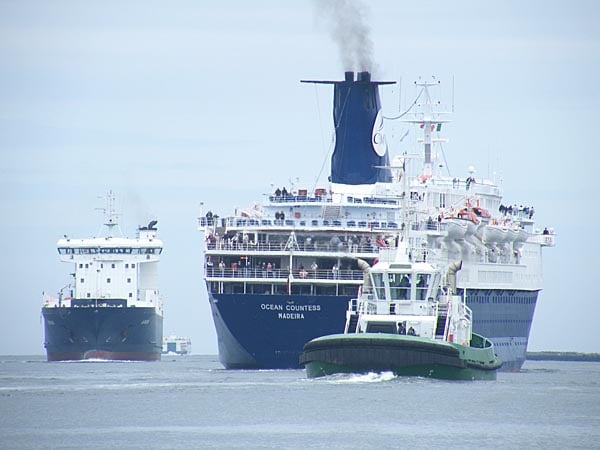
Ocean Countess departing Dublin. Photo: Jehan Ashmore/ShipSNAPS
A newcomer to Irish ports is Cruise & Maritime Voyages Ocean Countess which is making round Ireland itineraries with calls at Cobh on 13 August and 12 September. Incidently the 'Countess' was converted into a troopship for the Falkland Islands conflict in 1982.
Jewel of the Seas (90,090 GT) makes a Cobh call on 7 September and exactly a month later returns, marking the last cruise-call to Cork in 2010 while Fred Olsen's Boudicca will be Dublin's last caller on 20 November.
For further information on other visiting cruiseships, please click links:
Nuits St.George Tops the Ruffians
BENETEAU 31.7 ˆ ECHO 1. Levante (B.Leyden/M.Leahy), 2. Prospect (Chris Johnston), 3. Fiddly Bits (Kevin Byrne et al)
BENETEAU 31.7 - 1. Prospect (Chris Johnston), 2. Levante (B.Leyden/M.Leahy), 3. Fiddly Bits (Kevin Byrne et al)
CRUISERS 0 - ECHO 1. Lively Lady (Derek Martin), 2. WOW (George Sisk), 3. Tsunami (Vincent Farrell)
CRUISERS 0 - 1. WOW (George Sisk), 2. Lively Lady (Derek Martin), 3. Tsunami (Vincent Farrell)
CRUISERS 1 - ECHO 1. Axiom (M.O'Neill), 2. Something Else (J.Hall et al), 3. Indecision (Declan Hayes et al)
CRUISERS 1 - 1. Something Else (J.Hall et al), 2. Joker 11 (John Maybury), 3. Aztec 3 (Peter Beamish)
CRUISERS 2 - ECHO 1. Red Rhum (J Nicholson), 2. Kamikaze (P.Nash/B.McIntyre), 3. Peridot (Jim McCann et al)
CRUISERS 2 - 1. Red Rhum (J Nicholson), 2. Jawesome 11 (V.Kennedy/M.Dyke), 3. Smile (B O'Sulliva et al)
CRUISERS 3 - ECHO 1. Supernova (K.Lawless et al), 2. Hard on Port (Flor O'Driscoll), 3. Hyflyer (John Barnard)
CRUISERS 3 - 1. Supernova (K.Lawless et al), 2. Hard on Port (Flor O'Driscoll), 3. Cries of Passion (Bryan Maguire)
CRUISERS 4 - 1. Maranda (Myles Kelly), 2. Aslana (J.Martin/B.Mulkeen), 3. Rascal (K.Burke/S.Milner)
DRAGON - 1. Susele (Michael Halpenny), 2. Phantom (D.Williams/P.Bowring), 3. Chiang (Iain Finnegan)
FLYING FIFTEEN - 1. The Big Bow Wow (N.Meagher/N.Matthews), 2. As Good As It Gets (Alan Balfe), 3. Fifty Somethings (David Mulvin)
GLEN - 1. Glenmarissa (F.Elmes/W.Higgins), 2. Glendun (B.Denham et al), 3. Glencorel (B.Waldock/K.Malcolm)
RUFFIAN 23 - 1. Nuits St Georges (Alan Kirwan), 2. Diane ll (Bruce Carswell), 3. Ruffles (Michael Cutliffe)
SB3s - 1. Probably (William Riordan), 2. Alert Packaging (Justin Burke), 3. Design Security (Colin Galavan)
SHIPMAN - 1. Curraglas (John Masterson), 2. Poppy (Peter Wallis et al), 3. Macro One (Joseph Murray)
SIGMA 33 - 1. Rupert (R.Lovegrove/P.Varian), 2. White Mischief (Timothy Goodbody), 3. Leeuwin (Henry Leonard et al)
SQUIB - 1. Anemos (Pete & Ann Evans), 2. Kookaburra (P & M Dee), 3. Waverider (F.Gaynor/T.Bryan)
WHITE SAIL CRUISERS - ECHO 1. Afternoon Delight (Michael Bennett et al), 2. Calypso (Howard Knott), 3. Aurora (Ray Conway)
WHITE SAIL CRUISERS - 1. Calypso (Howard Knott), 2. Nauti-Gal (J & J Crawford), 3. Arwen (Philip O'Dwyer)
Majority of Lifejackets Fail Lifeboat Test
Over 90% of lifejackets tested at Ireland's two biggest sailing centres failed simple checks carried out by the Royal National Lifeboat Institute (RNLI) last week writes Irish Times Sailing Columnist David O'Brien.
From 91 jackets tested in Cork and Dublin, 83 failed a free inspection.
The annual Lifejacket check service carried out by the institute was only taken up by 40 sailors from an estimated 1,000 competing crews at Cork week. 35 failed the test.
In Dun Laoghaire, last Saturday the RNLI offered the service again prior to Dublin Bay racing, where the total fleet is over 300 boats, the country's biggest sailing centre. 51 from a possible 2500 lifejackets were checked. Only three were deemed ok.
There were several different reasons for the failures including rusty or out of date inflation capsules but the bulk were rejected because jackets were not fitted with crotch straps. "It is the RNLI opinion these lifejackets may not work to their full potential because they may not keep the wearer's airway above water", says the RNLI's Kevin Rahill.
It's an important point so it is a wonder how lifejackets can be sold without them. What is not explained though is why so few sailors took up the free check or why nearly half the lifejackets presented had out of date capsules?
There is little doubt there has been an increased use of lifejackets in recent years but as last weeks survey shows it's equally important to know the lifejacket you are wearing actually works if you end up in the water.
RNLI Lifejacket Checks
Crosshaven:
LJs Checked 40
Ok 5
No Crotch Strap 18
OOD Capsule 22
OOD Hammar 1
Mk 3 Head 1
Rusty Cyl 2
Slack or Cyl out 4
Fired 3
Condemned (evidence of severe damage to fabric, mechanism etc) 1
Dun Laoghaire:
LJs Checked 51
Ok 3
No Crotch Strap 30
OOD Capsule 21
OOD Hammar 9
Mk 3 Head 1
Rusty Cyl 4
Slack or Cyl out 2
Fired 1
Condemned (evidence of severe damage to fabric, mechanism etc) 5
Since this article first appeared in the Irish Times on Friday, July 27 plans are afoot to test Lifejackets again in Dun Laoghaire in August or September.
We want your view on our forum thread HERE!
Related Safety posts
RNLI Lifeboats in Ireland
Safety News
Rescue News from RNLI Lifeboats in Ireland
Coast Guard News from Ireland
Water Safety News from Ireland
Marine Casualty Investigation Board News
Marine Warnings



























